Principle 7:
Continuance
7 June 2020
The 7 Principles of Conversion-Centered Landing Page Design: Continuance
If you’ve ever played The Sims, you’ll know that the real fun begins with new expansions. From taking your pixelated family on a tropical holiday to building a luxury mansion for your vampire clan, additional content is where the magic is at.
In conversion-centered design (CCD), your final goal is to create a similar experience for your new customers. How can you continue their experience in a way that’s awesome for them and lucrative for your business?
We call this continuance and it’s the last principle in CCD. (If this leaves you bamboozled, you’ll need to play catch up. Start here.
For those who’ve been following this series, let’s help you nail this final step to securing the maximum value from your customers.
What are you asking for?
Is the first question you need to answer. Do you want the customer to share your offering on Twitter or Facebook? Sign up to your webinar? Subscribe to your blog?
Think about what your customer wants, too. Will this experience or purchase be of use to them? How will it fulfil their needs or solve a problem?
If you’re unclear, study your customer personas again, concentrating on their motives, pains and desires. Study how you’re going to create an emotional link between your new customer and the Continuance action. As the great Peter Drucker once said:
“The aim of marketing is to know and understand the customer so well, the product or service fits them and sells itself.”
Getting cool cucumbers to commit.
Right now, your newly converted customers aren’t looking for anything intense. They’ve already put in the effort to engage with your business. If you’re asking more from them, you’ve got to make it simple and fast.
That’s why it’s useful to write down a list of the types of things you’re thinking of asking people to do. Then next to each action, add a score that represents the level of commitment required to perform it.
You can see what we mean below:

The more questions and information you ask of your customers, the more effort it takes to complete the continuance action. And remember, at this point in the customer lifecycle, they don’t want to feel pushed into doing something tricky or time-consuming.
For example, if they’ve just submitted all their personal information to register for a webinar, getting them to hand over their payment details for a software trial is a big ask. So you might want to take the commitment level down a few notches. A free demo that only requires a few clicks is a good place to start.
Bonus: mosey your way back to our guide on closing to ensure your new CTA copy for continuance is compellingly-clickable.
Evergreen campaigns.
Every marketer dreams of pulling off a successful evergreen campaign. Unlike standard campaigns, they don’t have a set end date. They can be long-lasting, perennially providing your business with new prospects and sales. In other words, they create opportunity for continuance.
It works like this: let’s say you created a landing page for an upcoming event you’re hosting. Right up until the big day, you’ll receive email, social and paid traffic that results in sign-ups.
Afterwards, you replace the registration form with a gated whitepaper, summarising the key lessons from the event. Because the content is still relevant and valuable, it has become evergreen and you’ll continue to get value out of your customers.
This is a fabulous opportunity to use a social share as your secondary continence action. So you can keep the momentum going in terms of traffic coming back to your landing page.
Congratulations!
You have reached the end of conversion-centered design. How do you feel? Like you never want to see the term ‘CCD’ ever again? I know, it’s a lot to take in. But, boy, has it been worth your time.
Armed with this knowledge, you can create campaigns and landing pages that are fool-proof ROI harvesters.
If you’re thinking, But where do I begin? Start your journey with a campaign you’re currently working on. Critically analyse the experience you’re orchestrating for prospects. Ask yourself:
Does it successfully capture and maintain prospects’ attention?
Is there good pre-click and post-click context?
Does your landing page and traffic source deliver clarity?
Have you aligned every element on the page with your singular campaign goal to maintain congruence?
Does it reference your business’ credibility?
Have you built a powerful case for closing?
What have you done to create a journey of continuance?
Use these questions as your personal CCD checklist when reviewing your current campaigns and creating new ones. You’ll create a clear path to conversion for prospects, helping them find what they want easily, and helping you build trust and sales through a great user experience.